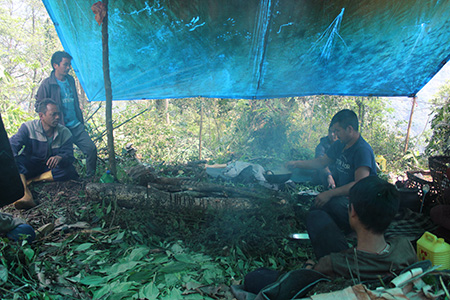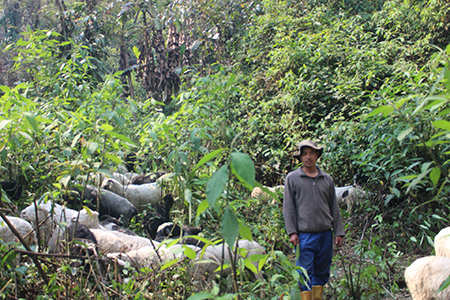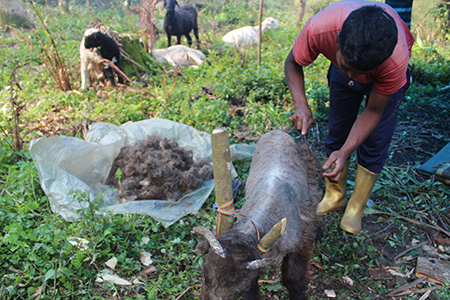Fieldwork
I conducted my MPhil dissertation fieldwork among the Gurung community in the hills of west Sikkim, Northeast India. My fieldwork was primarily conducted in the two villages of Labdang and Nar Khola, located in the foothills of the Kanchenjunga ranges near the India-Nepal border. Gurung men in these two villages have traditionally lived as shepherds grazing their sheep in the high Himalaya, but since 1977, when large tracts of forest lands were "discovered" as a biodiversity hotspot and declared the Kanchenjunga National Park (KNP), their access to the forests has been severely affected. Moreover, in 2016, KNP was declared a UNESCO world heritage site, further restricting the limited access the villagers had been able to negotiate for foraging and grazing.
My research is twofold: First, it focuses on the forest conservation policy of the government within the larger politics of frontier-making in India’s North-eastern borderlands. Second, it explores ethnic identity formation in the eastern Himalaya against the backdrop of emerging environmental challenges, frequent landslides, and large developmental projects. I argue, that in the "age of Anthropocene," ethnic boundaries and ethnic solidarities are formed not only vis-à-vis other ethnic groups (Barth 1969; Guneratna 2002), but that today there are more-than-human factors involved in shaping ethnic identity among eastern Himalaya communities.
Lunchtime in the “Goth”
Shepherds and their sheep are collectively called "Goth" in Nepali (the language spoken by the Gurungs in west Sikkim). In Labdang, the 1977 demarcation of KNP had led many villagers to give up sheep rearing, shifting to alternate professions (mainly farming). But in 2021, villagers decided to revive sheep-rearing once again, bringing together all their sheep to create a goth. This decision to start sheep rearing again was fuelled by both economic reasons since sheep meat, wool, and milk provide good economic revenue and by cultural reasons because the villagers believed that they had to keep their ancestral tradition alive. During my fieldwork in April 2023, the goth in Labdang had around 170 sheep, and young and middle-aged men in the village took turns to graze the sheep in the remaining forest areas that were not affected by KNP. Often in the mornings, people asked each other about the location of the goth since the goth kept shifting from one place to another in search of fodder for the sheep. Asking each other, "Where has the goth reached today?" was a common way of greeting in Labdang. On one such day, I was told by my hosts that the goth had reached quite close to the village and that it would be suitable for me to visit the goth. After three hours of walking down a steep, rugged hill, I reached the goth during the shepherds’ lunchtime, and this photograph was taken in their tent where they were preparing their lunch: a simple meal of chicken curry and rice.
Indigenous knowledge systems and livelihoods
In this photograph, a young shepherd stands alongside a large number of sheep in the forest. Gurung shepherds have extensive knowledge about the landscape of the west Sikkim hills. Apart from geographical knowledge, they also have extensive knowledge about the plants, trees, insects, and animals found in the forest. During my walk to the goth, my guide (also Gurung) kept pointing at various plants and telling me about their medicinal qualities. Moreover, the shepherds develop a close relationship with all the sheep in their herd. Not only do they know every single sheep in their herd, assigning each sheep its own name, but they also have a unique way of communicating with the sheep—often involving hooting or whistling—which the sheep understand, showcasing the multispecies entanglement that exists between the sheep, Gurung shepherds, and the forests in west Sikkim (Govindranjan 2018; Wijunamai 2023). Often, my conversation with the shepherds would be interrupted by the bleating cry of a sheep who had walked quite far from the rest of the herd, and the shepherd would recognise the sheep instantly, saying, "Bikas has reached that end of the hill; I have to go get him back with the rest of the herd".
Fluid Boundaries
This photograph was taken in a different goth at my second field site, Nar Khola, in west Sikkim. Nar Khola is a comparatively smaller village than Labdang, but like Labdang, it is mainly inhabited by the Gurung community. Nar Khola is located approximately two hills behind Labdang, right next to the Nar Kola River, and the forest areas near the village do not fall under KNP. Therefore, the shepherds in this village have not been affected by the demarcation of KNP and the grazing ban. The Gurung shepherds in Nar Khola have larger numbers of sheep than Labdang, and due to a shortage of labour, they often employ men from other communities to take care of their sheep. The shepherd in this photograph is not Gurung but belongs to the Mangar community. In this photograph, the shepherd is cutting wool (unn) from a young sheep. This wool (unn) will then be sold in neighbouring villages such as Begha and Sardung, where it will be washed, dried, and woven to make carpets, coats, hats, etc.



